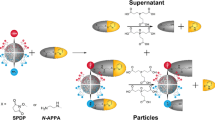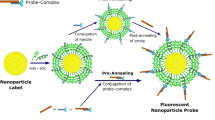Abstract
An oligoethylene glycol-based propargyl phosphonate was applied to functionalize the surface of LaPO4:Ce,Tb nanoparticles in situ during the particle synthesis. The application of the surface modification reagent did not alter either size (5–7 nm in diameter) or morphology of the nanocrystalline core, but provided efficient anchor groups for subsequent coupling of a carbohydrate model receptor under mild reaction conditions. The biofunctionalization efficiency was quantified by thermogravimetric analysis and confirmed by a photometric assay. A calculation-based estimation suggested an average number of about 20 biomarkers per nanoparticles and a surface density of about 1 marker per 6 nm−2.








Similar content being viewed by others
References
Bernadi A, Jiménez-Barbero J, Casnati A, De Castro C, Darbre T, Fieschi F, Finne J, Funken H, Jaeger K-E, Lahmann M, Lindhorst TK, Marradi M, Messner P, Molinaro A, Murphy PV, Nativi C, Oscarson S, Penadés S, Peri F, Pieters RJ, Renaudet O, Reymond J-L, Richichi B, Rojo J, Sansone F, Schäffer C, Turnbull WB, Velasco-Torrijos T, Vidal S, Vincent S, Wennekes T, Zuilhof H, Iberty A (2013) Multivalent glycoconjugates as anti-pathogenic agents. Chem Soc Rev 42:4709–4727
Berowitz PT, Baum K (1981) Reactions of 2-fluoro-2-nitro-1,3-propandiol, p-toluenesulfonates. J Org Chem 46:3816–3819
Bo Z, Zhang X, Yi X, Yang M, Shen J, Rehn Y, Xi S (1997) The synthesis of dendrimers bearing alkyl chains and their behavior at air-water interface. Polym Bull 38:257–264
Boduszek B (1997) Aminophosphonic acids bearing heterocyclic moiety. Part 4. Synthesis of 2-pyridyl and 4-pyridylmethyl(amino)phosphonic acids. Phosphorus Sulfur Silicon 122:21–32
Bouzigues C, Gacoin T, Alexandrou A (2011) Biological applications of rare-earth based nanoparticles. ACS Nano 5:8488–8505
Chen JC, Luo WQ, Wang HD, Xiang JM, Jin HF, Chen F, Cai ZW (2010) A versatile method for the preparation of end-functional polymers onto SiO2 nanoparticles by combination of surface-initiated ATRP and Huisgen [3 + 2] cycloaddition. Appl Surf Sci 256:2490–2495
Deussen H-J, Danielsen S, Breinholt J, Borchert TV (2000) A novel biotinylated suicide inhibitor for directed molecular evolution of lipolytic enzymes. Bioorg Med Chem 8:507–513
Erathodiyil N, Ying JY (2011) Functionalization of inorganic nanoparticles for bioimaging applications. Acc Chem Res 44:925–935
Gao W, Dickinson L, Grozinger C, Morin FG, Reven L (1996) Self-assembled monolayers of alkylphosphonic acids on metal oxides. Langmuir 12:6429–6435
Gruar RI, Tighe CJ, Muir J, Kittler JT, Wodjak M, Kenyon AJ, Darr JA (2012) Continous hydrothermal synthesis of surface-functionalised nanophosphors for biological imaging. RSC Adv 2:10037–10047
He H, Gao C (2011) Click chemistry on nano-surfaces. Curr Org Chem 15:3667–3691
Kango S, Kalia S, Celli A, Njuguna J, Habibi Y, Kumar R (2013) Surface modification of inorganic nanoparticles for development of organic-inorganic nanocomposites—a review. Prog Polymer Sci 38:1232–1261
Kohler B, Bohmann K, Hoheisel W, Haase M, Haubold S, Meyer C, Heidelberg T (2006) Production and use of in situ-modified nanoparticles. US2006/0063155 A1
Kolb HC, Finn MG, Sharpless KB (2001) Click chemistry: diverse chemical function from a few good reactions. Angew Chem Int Ed 40:2004–2021
Lallana E, Riguera R, Fernandez-Megia E (2011) Reliable and efficient procedures for the conjugation of biomolecules through Huisgen azide-alkyne cycloaddition. Angew Chem Int Ed 50:8794–8804
Lane SM, Monot J, Petit M, Tellier C, Bujoli B, Talham DR (2008) Poly(dG) spacers lead to increased surface coverage of DNA probes: an XPS study of oligonucleotide binding to zirconium phosphate modified surfaces. Langmuir 24:7394–7399
Lehmann O, Meyssamy H, Kompe K, Schnablegger H, Haase M (2003) Synthesis, growth and Er3+ luminescence of lanthanide phosphate nanoparticles. J Phys Chem B 107:7449–7453
Liang L, Astruc D (2011) The copper(I)-catalyzed alkyne-azide cycloaddition (CuAAC) ‘click’ reaction and its applications. An overview. Coord Chem Rev 255:2933–2945
Lin M, Zhao Y, Wang SQ, Liu M, Duan ZF, Chen YM, Li F, Xu F, Lu TJ (2012) Recent advances in synthesis and surface modification of lanthanide-doped upconversion nanoparticles for biomedical applications. Biotechnol Adv 30:1551–1561
Liu Y, Tu D, Zhu H, Chen X (2013) Lanthanide-doped luminescent nanoprobes: controlled synthesis, optical spectroscopy, and bioapplications. Chem Soc Rev 42:6924–6958
Lu X, Lv X, Sun Z, Zheng Y (2008) Nanocomposites of poly(L-lactide) and surface-grafted TiO2 nanoparticles: synthesis and characterization. Eur Polymer J 44:2476–2481
Mader HS, Kele P, Saleh SM, Wolfbeis OS (2010) Upconverting luminescent nanoparticles for use in bioconjugation and bioimaging. Curr Opinion Chem Biol 14:582–596
Moni L, Rossetti S, Marra A, Dondoni A (2010) Immobilization of calix[4]arene-based glycoclusters on TiO2 nanoparticles via Cu(I)-catalyzed azide-alkyne coupling. Chem Commun 46:475–477
Nguan HS, Heidelberg T, Hashim R, Tiddy GJT (2010) Quantitative analysis of the packing of alkyl glycosides: a comparison of linear and branched alkyl chains. Liq Cryst 37:1205–1213
Norberg O, Deng L, Yan M, Ramström O (2009) Photo-click immobilization of carbohydrates on polymeric surfaces—a quick method to functionalize surfaces for biomolecular recognition studies. Bioconjugate Chem 20:2364–2370
Queffelec C, Petit M, Janvier P, Knight DA, Bujoli B (2012) Surface modification using phosphonic acids and esters. Chem Rev 112:3777–3807
Riwotzki K, Meyssamy H, Kornowski A, Haase M (2000) Liquid-phase synthesis of doped nanoparticles: Colloids of luminescing LaPO4:Eu and CePO4:Tb particles with a narrow particle size distribution. J Phys Chem B 104:2824–2828
Riwotzki K, Meyssamy H, Schnablegger H, Kornowski A, Haase M (2001) Liquid-phase synthesis of colloids and redispersible powders of strongly luminescing LaPO4:Ce, Tb nanocrystals. Angew Chem Int Ed Engl 40:573–576
Saha SK, Brewer OF (1994) Determination of concentrations of oligosaccharides, complex type carbohydrates, and glycoproteins using the phenol-sulfuric acid method. Carbohydr Res 254:157–167
Sahiner N, Sagbas S (2014) The use of poly(vinyl phosphonic acid) microgels for the preparation of inherently magnetic Co metal catalyst particles in hydrogen production. J Power Sources 246:55–62
Salman AA, Heidelberg T, unpublished results currently submitted for publication
Sapsford KE, Algar WR, Berti L, Boeneman Gemmill K, Casey BJ, Oh E, Stewart MH, Medintz IL (2013) Functionalizing nanoparticles with biological molecules: developing chemistries that facilitate nanotechnology. Chem Rev 113:1904–2074
Sreenivasan VKA, Zvyagin AV, Goldys EM (2013) Luminescent nanoparticles and their applications in life sciences. J Phys Condens Matter 25:194101–194123
Sun M, Li Z-J, Liu C-L, Fu H-X, Shen J-S, Zhang H-W (2014) Persistent luminescent nanoparticles for super-long time in vivo and in situ imaging with repeatable excitation. J Lumin 145:838–842
Tasdelen MA, Camp WV, Goethals E, Dubois P, Prez FD, Yagci Y (2008) Polytetrahydrofuran/clay nanocomposites by in situ polymerization and ‘click’ chemistry processes. Macromolecules 41:6035–6040
Vill V, Thiem J, Fischer B (1986) Studies on liquid-crystalline glycosides. Liq Cryst 6:349–356
White MA, Johnson JA, Koberstein JT, Turro NJ (2006) Towards the synthesis of universal ligands for metal oxide surfaces: controlling surface functionality through click chemistry. J Am Chem Soc 128:11356–11357
Zalipsky S (1995) Chemistry of polyethylene glycol conjugates with biologically active molecules. Adv Drug Deliv Rev 16:157–182
Zhao J, Liu Y, Park H-J, Boggs JM, Basu A (2012) Carbohydrate-coated fluorescent silica nanoparticles as probes for the galactose/3-sulfogalactose carbohydrate–carbohydrate interaction using model systems and cellular binding sites. Bioconjugate Chem 23:1166–1173
Zhou Y, Wang S, Xie K, Dai Y, Ma W (2011) Versatile functionalization of Fe3O4 nanoparticles via RAFT polymerization and click chemistry. Appl Surf Sci 257:10384–10389
Acknowledgments
Financial support for this work by the University of Malaya under research Grants RG026-09AFR, RP024-2012B, PS380-2010B, and RG264-13AFR is gratefully acknowledged.
Author information
Authors and Affiliations
Corresponding author
Electronic supplementary material
Below is the link to the electronic supplementary material.
11051_2014_2399_MOESM1_ESM.pdf
Supporting Information: Experimental details on the synthesis of surface modification reagents and the receptor model, including images of spectra to support the purity of the reagents, are provided as supplementary material. Besides, the material also includes experimental data for SAXS and the phenolic carbohydrate assay, as well as details on the calculation-based estimation of the receptor loading density on the coupled nanoparticle 11. (PDF 844 kb)
Rights and permissions
About this article
Cite this article
Salman, A.A., Heidelberg, T. In situ functionalized fluorescent nanoparticles for efficient receptor coupling. J Nanopart Res 16, 2399 (2014). https://doi.org/10.1007/s11051-014-2399-x
Received:
Accepted:
Published:
DOI: https://doi.org/10.1007/s11051-014-2399-x




